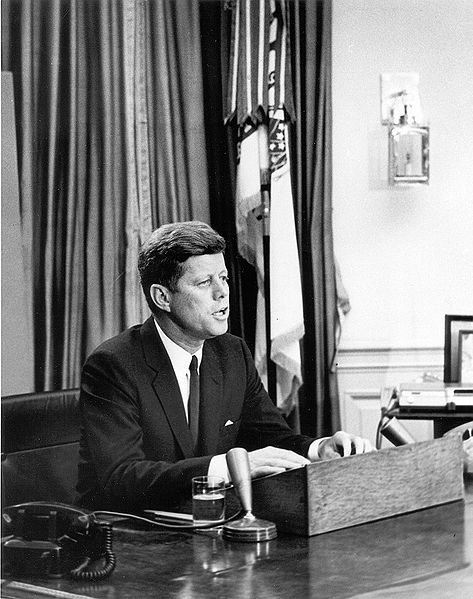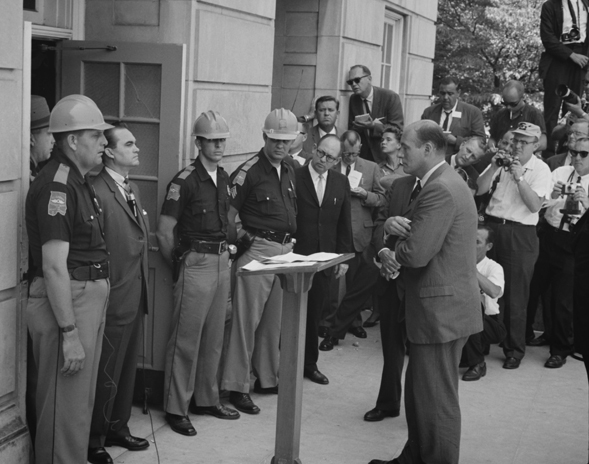
All baby boomers can tell you exactly where they were and what they were doing on November 22, 1963. The murder of John F. Kennedy was a defining moment of their childhood, just as Pearl Harbor was for the preceding generation, and 9/11 was for the millennials.
A half-century of books and movies related to the assassination have made that afternoon in Dallas the most frequently recalled event of 1963. Unfortunately, its prominence in public memory overshadows other events that eventually shaped our lives far more than the death of the president.
Black Americans’ fight for equal rights had become hard to ignore in 1963. It had broadened from the 1957 confrontation at Little Rock Central High School where federal troops had enforced the right of black students to attend a previously all-white high school. And this action had arisen from the Supreme Court’s decision in 1954, outlawing segregated schooling, which would separate children into all-white or decidedly inferior all-black schools.
A Post editorial in February 1963 (“Bad words and good words down South”) observed the varying responses to black protest and legal challenges among southern states. In Alabama, they noted, there was no talk of compromise or acceptance. George Wallace, then governor of Alabama, had chosen to be sworn into office standing precisely where Jefferson Davis stood when he was sworn as the Confederacy’s first president. “As far as Wallace was concerned,” Post editors wrote, “the interval since Jeff Davis might just as well not have occurred. ‘I draw the line in the dust and toss the gauntlet before the feet of tyranny,’ Gov. Wallace said. ‘I say segregation now, segregation tomorrow, segregation forever.’”
In contrast, the governors of South and North Carolina were talking of life beyond segregation.
In South Carolina, the new governor announced he would pursue “a sensible approach” to racial problems, which the state would work out “according to our standards of justice and decency.” In North Carolina, Gov. Terry Sanford had told the press, “The time has come to quit unfair discrimination and to give the Negro a full chance to earn a decent living for his family and to contribute to higher standards for himself and all men.”
These were reassuring words for white Americans who wanted to believe state governments would finally start implementing the end of “separate but equal” schools.
However, Carl T. Rowan wasn’t reassured. The journalist, then working with the secretary of state on public affairs, had seen little change in the nine years since the Brown v. Board of Education decision. Writing “The Travesty of Integration” (January 19, 1963) for the Post, he argued that what little change had taken place was, in fact, a carefully built illusion of progress. “Scores of communities have, by devious means, pretended to comply with the letter of the law while ignoring the spirit of justice and decency that the law embodies.”
Of North Carolina’s 173 school districts, only 16 had ended segregated schooling. “In those 16 supposedly integrated districts last year, only 901 Negro children were in school with white youngsters. The other 77,404 colored pupils … were still in all-Negro schools.”
Rowan also referred to Prince Edward County, Virginia, where, in 1959, the board of supervisors withdrew all funding from the public schools rather than comply with an integration order. For the next five years, all schools in the county remained closed—except for private, foundation-operated schools that admitted only white children.

“In Texas, they may boast about the ‘peaceful transition’ to ‘integration’ in Dallas or Houston,” Rowan added, “but the meaningful thing to me is that a ‘whopping’ 2.16 percent of the Negro children in that state attended integrated schools last year.”
Even where integration had begun, administrators were suggesting policies that only reinforced racial stereotypes.
“In Little Rock, some ‘moderates’ argued at first that all the Negroes in the first group to be admitted to white schools ought to be light-skinned. In other communities there have been demands that all Negroes in the token delegation be girls—so as to preclude the ‘wrong kind’ of interracial romances.”
Rowan couldn’t understand why the federal government could enforce its tax laws so effectively but prove so ineffectual in guaranteeing civil rights for all its citizens. He believed Americans would either have to push their government to enforce the laws or live with the change that came in response to sit-ins, demonstrations, possible violence, and near anarchy.
Wallace believed there was a third choice, which was to stubbornly resist all change. On June 11, 50 years ago, he stood in the doorway of Foster Auditorium at the University of Alabama. In an event staged for the media, he refused to step aside and allow Vivian Malone Jones and James Hood, two black students, to enter and register for enrollment. The U.S. deputy attorney told Wallace to move. Wallace refused and launched into a speech about states’ rights. The deputy attorney phoned the White House. In response, President Kennedy ordered the National Guard to clear the doorway. Wallace moved out of the way.
Later that same day, the president addressed the nation to announce that the federal government would finally undertake a legislative initiative to ensure civil rights. Kennedy asked for legislation to outlaw racial discrimination and segregation, ensure voting rights, and guarantee equal protection under the law for all citizens. His proposal was realized in the Civil Rights Act, which was eventually signed into law by Lyndon Johnson in 1964.
After hearing the news from Alabama and Washington, Americans might have gone to bed that night with a sense that, finally, the country was seeing the end of the protests, anger, and violence in the fight for civil rights.
The next day, June 12, civil rights activist Medgar Evers was shot in the back and killed as he returned home from a meeting with NAACP lawyers. His killer was Byron De La Beckwith, a member of the White Citizens’ Council, who eluded punishment for 21 years. The fight was far, far from over.
Become a Saturday Evening Post member and enjoy unlimited access. Subscribe now



